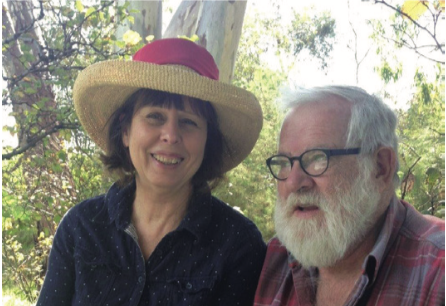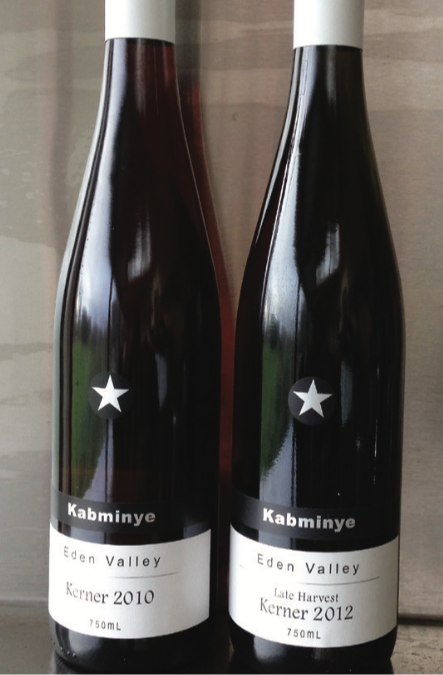By Rick and Ingrid Glastonbury Kabminye Wines, Barossa Valley, South Australia
First published in the July/August 2016 issue of the Wine & Viticulture Journal

 Some 20 years ago, Victoria’s Robinvale Wines became what appears to be the only winery in Australia to take up an offer from the CSIRO in Merbein, Victoria, to supply Kerner vine cuttings, which were planted in its own certified organic and biodynamic vineyard at Robinvale on the Murray River. The Caracatsanoudis family went on to make wine from the Kerner fruit, winning many gold and sil ver awards.
Some 20 years ago, Victoria’s Robinvale Wines became what appears to be the only winery in Australia to take up an offer from the CSIRO in Merbein, Victoria, to supply Kerner vine cuttings, which were planted in its own certified organic and biodynamic vineyard at Robinvale on the Murray River. The Caracatsanoudis family went on to make wine from the Kerner fruit, winning many gold and sil ver awards.
Around 1974, Rick Glastonbury tasted a Kerner wine from Germany and decided he wanted to make wine from the grape variety. He set about trying to source some cuttings from the CSIRO to plant in his family’s vineyard at Forest Range in the Adelaide Hills but was t old none were available, and that he would not see them in Australia in his lifetime.
In 2002, after setting up Kabminye Wines in the Barossa Valley, we discovered that Robinvale Wines was making wine with Kerner, and very good wine at that. We contacted the CSIRO again and was told there was none left in its source block, so we contacted Bill Caracatsanoudis at Robinvale Wines and were pleased to find that Bill was more than happy to let us have some cuttings. We drove to Robinvale and took the cuttings ourselves with Bill’s help, driving back through Mildura where the vines were fumigated before crossing the border into South Australia. It seems these were the only cuttings distributed from the Caracatsanoudis’ vineyard.
Once back in the Barossa the question arose, what to do with the vine cuttings? First of all, the precious babies were stored in the Yalumba Nursery coolroom for a year until they were ready to callous and plant out.
We really wanted to plant them in the cooler climes of Eden Valley, rather than the valley floor where the little Kabminye vineyard was, so we looked for someone to plant them for us. Our vineyard contractor offered, but decided they didn’t have enough space. Fortunately, at around this time, Michael and Graham Fechner approached us and asked if we had any grape varieties we would like them to plant in their vineyard in Moculta, about 15km east of Nuriootpa. Yes, we said, and offered them the Kerner cuttings on the basis that they would plant out the 2000 cuttings and Kabminy e Wines would take the grapes from the vines and make wine from them.
Kabminye Wines first Kerner vintage in 2008 was made dry in the traditional Eden Valley Riesling style. Rick experimented with various styles, making a dry, late harvest and mistelle version (adding grape spirit to unfermented juice), as well as blending it with White Frontignac.
Tasting notes for the currently available Kabminye Kerner wines are as follows:
2010 Kerner
The 2010, our best crop so far, is again a crisp, bone-dry white with lively tropical fruit aromatics that lead into zingy pear, citrus and lychee flavours. Delicious with natural oysters on a hot afternoon.
2012 Late Harvest Kerner
In 2012 the mild summer allowed us to let the grapes ripen several weeks longer than in previous years, developing more concentrated tropical fruit flavours without losing Kerner’s trademark crispness. Refreshing, fruity and off-dry.
The Fechners have since increased the size of their original vineyard and gone on to make their own wines with their Kerner grapes as well as supplying their fruit to other wineries.
The Kerner grape variety would appear to be very hardy, growing in the warmer Riverland region through to snowy regions in Japan, and producing good quality wine across all of these regions.
KERNER

By Peter Dry Emeritus Fellow, The Australian Wine Research Institute
BACKGROUND
Kerner (kair-ner) is the result of a cross of Schiava Grossa (syn. Trollinger) and Riesling made at Weinsberg, Germany, in 1929. This parentage has been confirmed by DNA profiling. Authorised in 1969, it has become the most widely planted of the 20th century German crosses. At present, Kerner is the fifth most planted variety in Germany with 3510ha (2010). It is grown in most regions (mainly Rheinhessen and Rheinpfalz) but does not make up more than 5% of the total planted area of any region. There are also small areas in Italy (mainly Alto Adige), Switzerland, UK, Canada and Japan. In Australia the current area is very small and there are at least two wine producers (Barossa Valley and Murray Darling).
VITICULTURE
Budburst is late and maturity is mid-season. Vigour is high. Bunches are medium and compact with medium berries. Yield is moderate. Kerner is popular with German growers because, compared with Riesling, it has higher and more reliable yield and can be grown in a wider range of sites. It also has the ability to ripen to higher Brix levels than Mueller-Thurgau. Cane pruning is used in Germany. It is more susceptible to powdery mildew than average but has good cold tolerance.
WINE
Wines are fresh and racy, similar to Riesling but with more body and lower acidity. Descriptors include white fruits, apple, grapefruit, mango and Muscat. Although the Australian experience has been mainly in warm to hot regions – where the wines have been good – Kerner may have its best potential in cool regions.












